The MSI Z97A Gaming 6 Motherboard Review
by Ian Cutress on July 24, 2015 9:00 AM EST- Posted in
- Motherboards
- Gaming
- MSI
- Z97
System Performance
Power Consumption
Power consumption was tested on the system while in a single MSI GTX 770 Lightning GPU configuration with a wall meter connected to the OCZ 1250W power supply. This power supply is Gold rated, and as I am in the UK on a 230-240 V supply, leads to ~75% efficiency > 50W, and 90%+ efficiency at 250W, suitable for both idle and multi-GPU loading. This method of power reading allows us to compare the power management of the UEFI and the board to supply components with power under load, and includes typical PSU losses due to efficiency. These are the real world values that consumers may expect from a typical system (minus the monitor) using this motherboard.
While this method for power measurement may not be ideal, and you feel these numbers are not representative due to the high wattage power supply being used (we use the same PSU to remain consistent over a series of reviews, and the fact that some boards on our test bed get tested with three or four high powered GPUs), the important point to take away is the relationship between the numbers. These boards are all under the same conditions, and thus the differences between them should be easy to spot.
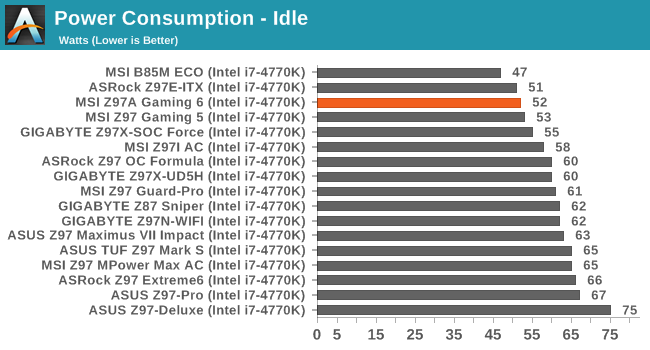
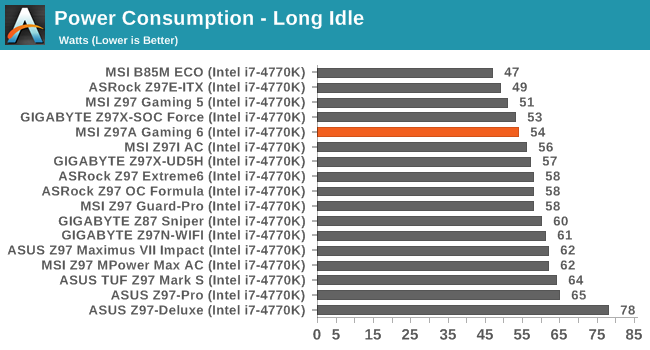
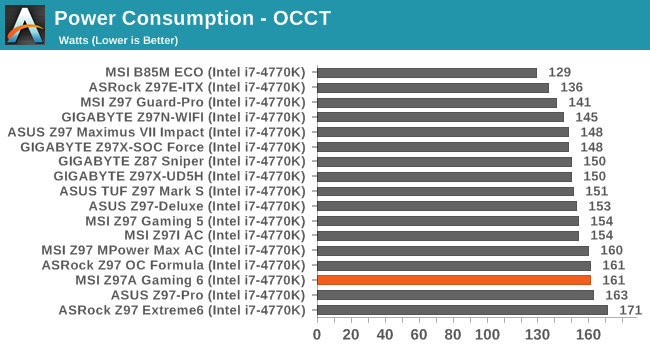
Power consumption in the idle states is actually pretty good, although loading the board pushes it down the order.
Windows 7 POST Time
Different motherboards have different POST sequences before an operating system is initialized. A lot of this is dependent on the board itself, and POST boot time is determined by the controllers on board (and the sequence of how those extras are organized). As part of our testing, we look at the POST Boot Time using a stopwatch. This is the time from pressing the ON button on the computer to when Windows 7 starts loading. (We discount Windows loading as it is highly variable given Windows specific features.)
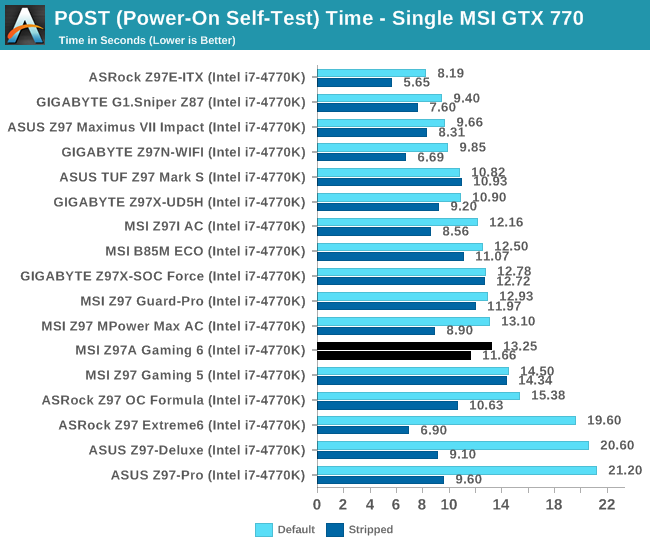
Rightmark Audio Analyzer 6.2.5
Rightmark:AA indicates how well the sound system is built and isolated from electrical interference (either internally or externally). For this test we connect the Line Out to the Line In using a short six inch 3.5mm to 3.5mm high-quality jack, turn the OS speaker volume to 100%, and run the Rightmark default test suite at 192 kHz, 24-bit. The OS is tuned to 192 kHz/24-bit input and output, and the Line-In volume is adjusted until we have the best RMAA value in the mini-pretest. We look specifically at the Dynamic Range of the audio codec used on board, as well as the Total Harmonic Distortion + Noise.
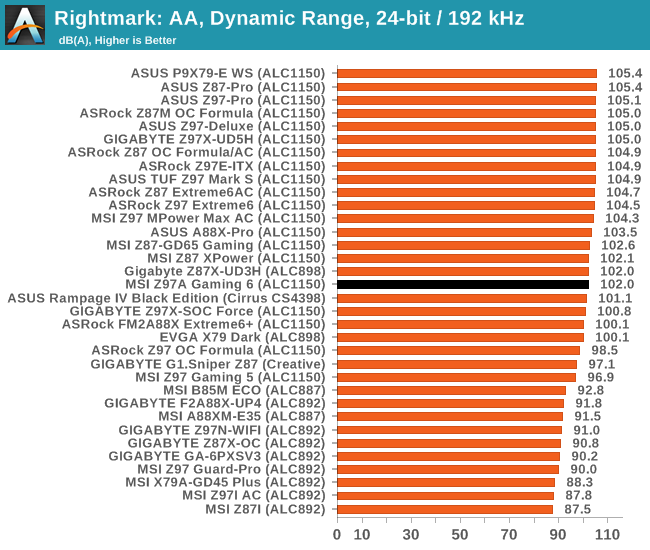
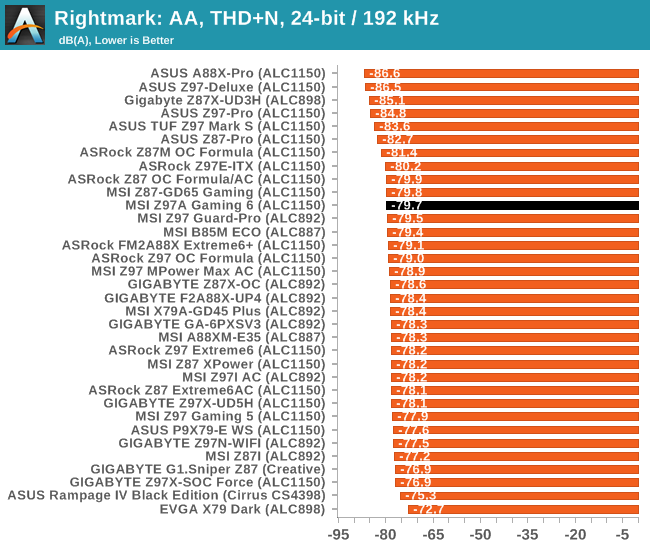
Audio results are middle of the line for the ALC1150 solution.
USB Backup
For this benchmark, we transfer a set size of files from the SSD to the USB drive using DiskBench, which monitors the time taken to transfer. The files transferred are a 1.52 GB set of 2867 files across 320 folders – 95% of these files are small typical website files, and the rest (90% of the size) are small 30 second HD videos. In an update to pre-Z87 testing, we also run MaxCPU to load up one of the threads during the test which improves general performance up to 15% by causing all the internal pathways to run at full speed.
Due to the introduction of USB 3.1, as of June 2015 we are adjusting our test to use a dual mSATA USB 3.1 Type-C device which should be capable of saturating both USB 3.0 and USB 3.1 connections. We still use the same data set as before, but now use the new device. Results are shown as seconds taken to complete the data transfer.
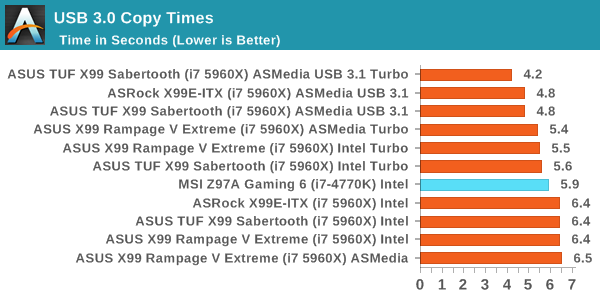
Unfortunately we were not able to source a Type-C to Type-C cable in time for this review for the USB 3.1 port, although the USB 3.0 ports for Z97 seem to outperform those of X99.
DPC Latency
Deferred Procedure Call latency is a way in which Windows handles interrupt servicing. In order to wait for a processor to acknowledge the request, the system will queue all interrupt requests by priority. Critical interrupts will be handled as soon as possible, whereas lesser priority requests such as audio will be further down the line. If the audio device requires data, it will have to wait until the request is processed before the buffer is filled.
If the device drivers of higher priority components in a system are poorly implemented, this can cause delays in request scheduling and process time. This can lead to an empty audio buffer and characteristic audible pauses, pops and clicks. The DPC latency checker measures how much time is taken processing DPCs from driver invocation. The lower the value will result in better audio transfer at smaller buffer sizes. Results are measured in microseconds.
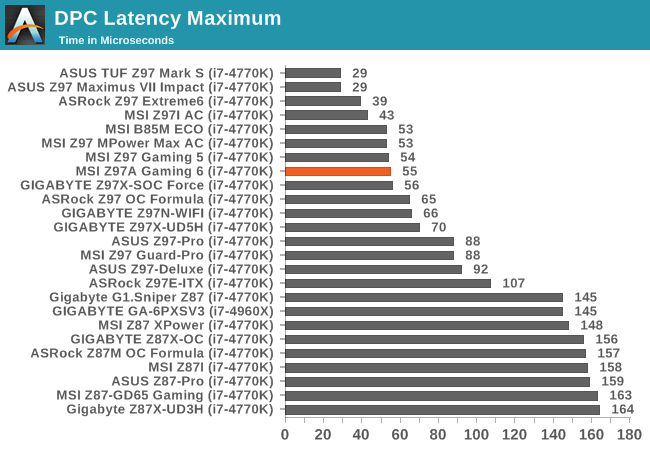
A good result for the Z97A Gaming 6, almost matching the Z97 Gaming 5 at just over 50 microseconds.










14 Comments
View All Comments
ct909 - Friday, July 24, 2015 - link
MSI are already publishing teaser images of their upcoming Z170A (Skylake ChipSet) Gaming MB, on their Facebook page:www.facebook.com/MSIHQFANCLUB/photos/a.190232534331918.41259.123693947652444/964188970269600
wintermute000 - Saturday, July 25, 2015 - link
pretty much... not sure why reviewing Z97 boards now!?!?!DanNeely - Friday, July 24, 2015 - link
The ASM 1142 controller supports two USB 3.1 ports; I'm baffled at the decision to only offer one.http://www.asmedia.com.tw/eng/e_show_products.php?...
sonny73n - Friday, July 24, 2015 - link
We got a pretty good review on the ASUS TUF X99 a few days ago. Thanks AT, for this review too.By the way, wouldn't it be better if AT do a review with at least 3 - 4 boards in the same price range so we can get a good comparison on their performances?